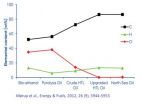(Press-News.org) TORONTO, Feb. 6, 2013—A popular class of drugs commonly used to treat sleep and mood symptoms continues to be frequently prescribed despite being known to have potentially life-threatening side effects.
Previous studies have linked benzodiazepines – a medication class that may be used in chronic obstructive pulmonary disease (COPD) to treat symptoms of insomnia, depression, anxiety and shortness of breath – with adverse outcomes, but until now there has been little information on how frequently it's prescribed or who is using it.
COPD, also known as emphysema or chronic bronchitis, is most commonly caused by smoking in North America and is estimated to affect 5 to10 per cent of the Canadian population. American Thoracic Society-European Respiratory Society guidelines recommend that benzodiazepines be avoided in these patients because of potential respiratory-related side-effects.
Dr. Nicholas Vozoris is the lead author of a study published this week in Drugs and Aging looking at the scope of benzodiazepine use in the older adult COPD population to determine just how many people are using the drug.
"I see a large number of COPD patients taking this medication class to help relieve disease-related symptoms like insomnia, depression and anxiety," said Dr. Vozoris, a respirologist at St. Michael's Hospital. "But considering the potential respiratory side-effects, and the well-documented neurocognitive side effects like memory loss, decreased alertness, falls and increased risk of motor vehicle accidents, the high frequency of benzodiazepine use in COPD is very concerning."
Dr. Vozoris and colleagues looked at more than 100,000 adults 66 years and older with COPD in Ontario between 2004 and 2009 to see how many new benzodiazepines were dispensed and the severity of each patients' COPD while on the drug.
The results found that new benzodiazepine dispensing was common and occurred in more than a third of the adults. Use of the drugs was 40 per cent more common amongst those with more severe COPD. This group also had the highest number of repeat prescriptions and early refills and benzodiazepines were also commonly dispensed to patients while they were having flare-ups of the disease.
"These findings are new and they are concerning because they tell us that the patients most at risk to be affected by the adverse effects of this drug are the same ones that are using it with the most frequency," Dr. Vozoris said. "This medication could be causing harm in this already respiratory-vulnerable population."
Although benzodiazepines can be effective for helping patients sleep, this medication class has been previously found to affect breathing ability and oxygen levels at night.
"Patients need to hear this and health care providers need to give thought into who they are prescribing this medication class to," Dr. Vozoris said. "We're talking about a very vulnerable sub-group and we may be inappropriately prescribing this medication class to those patients."
###
The study was funded by the Canadian Institutes of Health Research Institute of Nutrition, Metabolism and Diabetes.
About St. Michael's Hospital
St. Michael's Hospital provides compassionate care to all who enter its doors. The hospital also provides outstanding medical education to future health care professionals in more than 23 academic disciplines. Critical care and trauma, heart disease, neurosurgery, diabetes, cancer care, and care of the homeless are among the Hospital's recognized areas of expertise. Through the Keenan Research Centre and the Li Ka Shing International Healthcare Education Center, which make up the Li Ka Shing Knowledge Institute, research and education at St. Michael's Hospital are recognized and make an impact around the world. Founded in 1892, the hospital is fully affiliated with the University of Toronto.
For more information, or to speak to Dr. Vozoris please contact:
Kate Taylor
Communications Adviser
St. Michael's Hospital
Phone: 416-864-6060 x. 6537
TaylorKa@smh.ca
Inspired Care. Inspiring Science
www.stmichaelshospital.com
The respirology clinics at St. Michael's Hospital and inpatient beds, now located in some of the older wings, will be moving into the new patient care tower on the corner of Queen and Victoria Street in downtown Toronto in 2018.
Frequently prescribed drug used in concerning ways with harmful side effects
2013-02-07
ELSE PRESS RELEASES FROM THIS DATE:
11,000 elephants slaughtered in national park
2013-02-07
LIBREVILLE, GABON (February 6, 2013): The Wildlife Conservation Society (WCS) announced today that a national park, once home to Africa's largest forest elephant population, has lost a staggering 11,100 individuals due to poaching for the ivory trade.
The shocking figures come from Gabon's Minkebe Park, where recent surveys of areas within the park revealed that two thirds of its elephants have vanished since 2004. The majority of these losses have probably taken place in the last five years.
Gabon contains over half of Africa's forest elephants, with a population estimated ...
Children with ACL injuries require special treatment
2013-02-07
Until a child's bones have fully matured (in girls, typically by age 14; in boys, age 16), an injury to the anterior cruciate ligament (ACL)—the primary, stabilizing ligament of the knee joint—requires special consideration, treatment and care to ensure appropriate healing and to prevent long-term complications.
According to a review article in the February 2013 issue of the Journal of the American Academy of Orthopaedic Surgeons (JAAOS), ACL injuries once were considered rare in children and adolescents. However, the number of ACL injuries in young athletes is on the ...
Study: Buying luxury -- hedonistic or just French?
2013-02-07
A young woman in Tokyo pays 243,000 Yen for a Louis Vuitton suitcase emblazoned with the company's iconic monogram. A continent away, another woman purchases the same suitcase at the company's store on New York's 5th Avenue for the equivalent price in dollars, $3000. Why? What motivates their purchases? And, do those motivations hinge on their location?
That is precisely what Professor Jaehee Jung and her collaborators at universities in 9 other countries sought to answer. Their findings published recently in the journal, Psychology & Marketing, compared consumers' ...
Smartphones, tablets help scientists improve storm forecasts
2013-02-07
The next advance in weather forecasting may not come from a new satellite or supercomputer, but from a device in your pocket. University of Washington atmospheric scientists are using pressure sensors included in the newest smartphones to develop better weather forecasting techniques.
"With this approach we could potentially have tens or hundreds of thousands of additional surface pressure observations, which could significantly improve short-term weather forecasts," said Cliff Mass, a UW professor of atmospheric sciences.
Owners of certain new Android smartphones and ...
Happiness increases with age, across generations
2013-02-07
Psychological well-being has been linked to many important life outcomes, including career success, relationship satisfaction, and even health. But it's not clear how feelings of well-being change as we age, as different studies have provided evidence for various trends over time.
A new report published in Psychological Science, a journal of the Association for Psychological Science, reveals that self-reported feelings of well-being tend to increase with age, but that a person's overall level of well-being depends on when he or she was born.
Psychological scientist ...
Tiny capsule effectively kills cancer cells
2013-02-07
A tiny capsule invented at a UCLA lab could go a long way toward improving cancer treatment.
Devising a method for more precise and less invasive treatment of cancer tumors, a team led by researchers from the UCLA Henry Samueli School of Engineering and Applied Science has developed a degradable nanoscale shell to carry proteins to cancer cells and stunt the growth of tumors without damaging healthy cells.
In a new study, published online Feb. 1 in the peer-reviewed journal Nano Today, a group led by Yi Tang, a professor of chemical and biomolecular engineering and ...
Personalized health care will revolutionize 21st century medicine, says NJIT professor
2013-02-07
A closer look at personalized or point-of-care healthcare was the focus of a recent international conference in India organized and chaired by NJIT Distinguished Professor Atam Dhawan. The IEEE Engineering in Medicine and Biology Society (EMBS) International Special Topic Conference in point-of-care healthcare technologies, broadcast around the world, focused on topics ranging from 21st century medicine with new smart cross-and trans-disciplinary technologies to how wireless communications will change how physicians care for patients.
"The last century witnessed a ...
Stanford researcher sheds new light on the mysteries of spider silk
2013-02-07
As fibers go, there's never been anything quite like spider silk. Stretch it. Bend it. Soak it. Dry it out. Spider silk holds up. It is five times stronger than steel and can expand nearly a third greater than its original length and snap right back like new. Ounce-for-ounce spider silk is even stronger than Kevlar, the man-made fiber used in bulletproof vests.
It would be understandable to think that science knows all there is to know about the remarkable physics of spider silk, but the truth is far from that. Now, using a long-known-but-underutilized spectroscopy technique, ...
Hydrothermal liquefaction -- the most promising path to a sustainable bio-oil production
2013-02-07
To emphasize, the HTL process accepts all biomasses from modern society – sewage sludge, manure, wood, compost and plant material along with waste from households, meat factories, dairy production and similar industries.
It is by far the most feedstock flexible of any liquid fuel producing process, including pyrolysis, bio-ethanol, gasification with Fischer-Tropsch or catalytic upgrading of different vegetable or agro-industrial residual oils, and does not carry higher costs than these.
Hydrothermal liquefaction is basically pressure cooking, but instead of cooking the ...
India joined with Asia 10 million years later than previously thought
2013-02-07
CAMBRIDGE, Mass. -- The peaks of the Himalayas are a modern remnant of massive tectonic forces that fused India with Asia tens of millions of years ago. Previous estimates have suggested this collision occurred about 50 million years ago, as India, moving northward at a rapid pace, crushed up against Eurasia. The crumple zone between the two plates gave rise to the Himalayas, which today bear geologic traces of both India and Asia. Geologists have sought to characterize the rocks of the Himalayas in order to retrace one of the planet's most dramatic tectonic collisions.
Now ...



